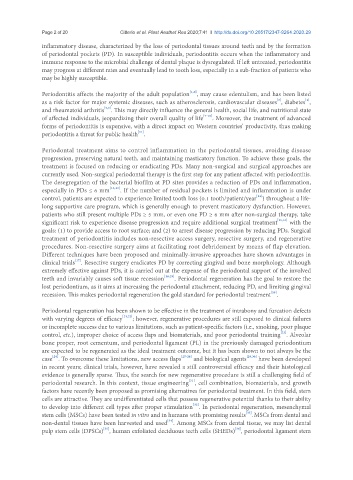Page 458 - Read Online
P. 458
Page 2 of 20 Citterio et al. Plast Aesthet Res 2020;7:41 I http://dx.doi.org/10.20517/2347-9264.2020.29
inflammatory disease, characterized by the loss of periodontal tissues around teeth and by the formation
of periodontal pockets (PD). In susceptible individuals, periodontitis occurs when the inflammatory and
immune response to the microbial challenge of dental plaque is dysregulated. If left untreated, periodontitis
may progress at different rates and eventually lead to tooth loss, especially in a sub-fraction of patients who
may be highly susceptible.
[1,2]
Periodontitis affects the majority of the adult population , may cause edentulism, and has been listed
[3]
as a risk factor for major systemic diseases, such as atherosclerosis, cardiovascular diseases , diabetes ,
[4]
[5,6]
and rheumatoid arthritis . This may directly influence the general health, social life, and nutritional state
of affected individuals, jeopardizing their overall quality of life [7-10] . Moreover, the treatment of advanced
forms of periodontitis is expensive, with a direct impact on Western countries’ productivity, thus making
periodontitis a threat for public health .
[11]
Periodontal treatment aims to control inflammation in the periodontal tissues, avoiding disease
progression, preserving natural teeth, and maintaining masticatory function. To achieve these goals, the
treatment is focused on reducing or eradicating PDs. Many non-surgical and surgical approaches are
currently used. Non-surgical periodontal therapy is the first step for any patient affected with periodontitis.
The desegregation of the bacterial biofilm at PD sites provides a reduction of PDs and inflammation,
especially in PDs ≤ 6 mm [12,13] . If the number of residual pockets is limited and inflammation is under
control, patients are expected to experience limited tooth loss (0.1 tooth/patient/year ) throughout a life-
[14]
long supportive care program, which is generally enough to prevent masticatory dysfunction. However,
patients who still present multiple PDs ≥ 5 mm, or even one PD ≥ 6 mm after non-surgical therapy, take
significant risk to experience disease progression and require additional surgical treatment [15,16] with the
goals: (1) to provide access to root surface; and (2) to arrest disease progression by reducing PDs. Surgical
treatment of periodontitis includes non-resective access surgery, resective surgery, and regenerative
procedures. Non-resective surgery aims at facilitating root debridement by means of flap elevation.
Different techniques have been proposed and minimally-invasive approaches have shown advantages in
clinical trials . Resective surgery eradicates PD by correcting gingival and bone morphology. Although
[17]
extremely effective against PDs, it is carried out at the expense of the periodontal support of the involved
teeth and invariably causes soft tissue recession [18,19] . Periodontal regeneration has the goal to restore the
lost periodontium, as it aims at increasing the periodontal attachment, reducing PD, and limiting gingival
recession. This makes periodontal regeneration the gold standard for periodontal treatment .
[20]
Periodontal regeneration has been shown to be effective in the treatment of intrabony and furcation defects
with varying degrees of efficacy [21,22] ; however, regenerative procedures are still exposed to clinical failures
or incomplete success due to various limitations, such as patient-specific factors (i.e., smoking, poor plaque
[23]
control, etc.), improper choice of access flaps and biomaterials, and poor periodontal training . Alveolar
bone proper, root cementum, and periodontal ligament (PL) in the previously damaged periodontium
are expected to be regenerated as the ideal treatment outcome, but it has been shown to not always be the
case . To overcome these limitations, new access flaps [25-28] and biological agents [29,30] have been developed
[24]
in recent years; clinical trials, however, have revealed a still controversial efficacy and their histological
evidence is generally sparse. Thus, the search for new regenerative procedure is still a challenging field of
[31]
periodontal research. In this context, tissue engineering , cell combination, biomaterials, and growth
factors have recently been proposed as promising alternatives for periodontal treatment. In this field, stem
cells are attractive. They are undifferentiated cells that possess regenerative potential thanks to their ability
to develop into different cell types after proper stimulation . In periodontal regeneration, mesenchymal
[32]
[33]
stem cells (MSCs) have been tested in vitro and in humans with promising results .MSCs from dental and
non-dental tissues have been harvested and used . Among MSCs from dental tissue, we may list dental
[34]
[35]
[36]
pulp stem cells (DPSCs) , human exfoliated deciduous teeth cells (SHEDs) , periodontal ligament stem

